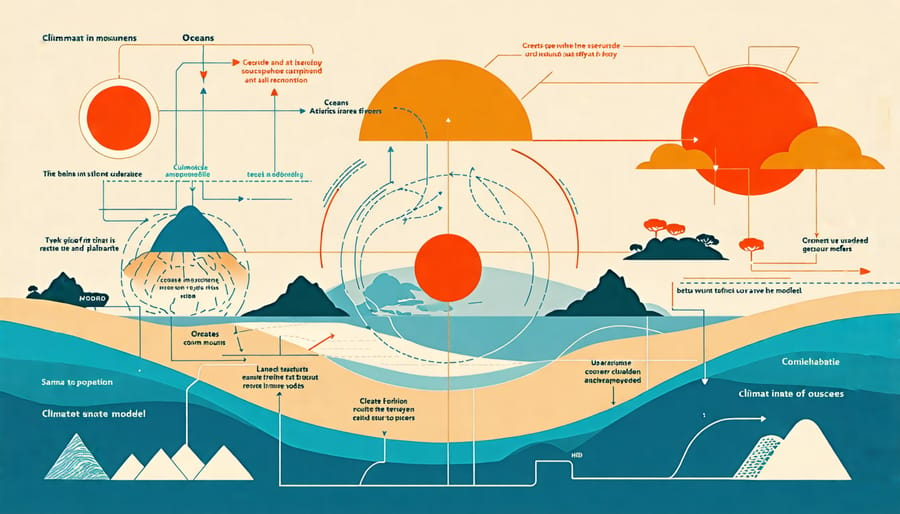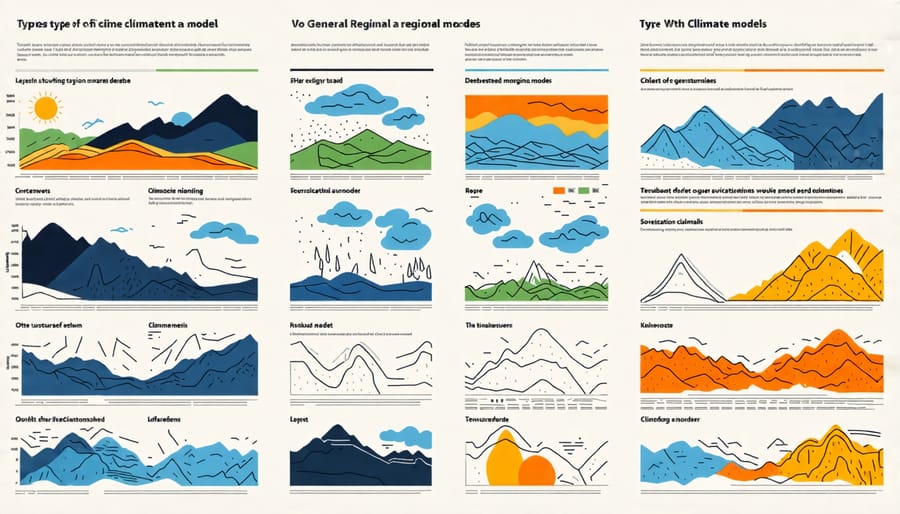Explore the definition and essence of climate modeling by analyzing its foundational principles in climate science. Recognize climate models as sophisticated computational tools that simulate Earth’s climate systems, aiding in the prediction of future climate scenarios based on varying greenhouse gas emissions. Appreciate the real-world applications, such as helping policymakers design effective strategies for mitigating climate change impacts and guiding industries in sustainable practices. Confront challenges like data precision and computing power, while embracing innovations such as machine learning and enhanced algorithms that refine model accuracy. Engage with expert insights from leading climate researchers to deepen understanding and acknowledge the importance of collaborative global efforts in this critical scientific field.
Defining Climate Modeling
Core Components of Climate Models
Climate models are vital tools for understanding our planet’s evolving climate, and their core components are fundamental to their accuracy and usefulness. At the heart of these models are the intricate systems of the atmosphere, oceans, and land surfaces. These components work in harmony to simulate Earth’s climate dynamics. The atmosphere is modeled to understand temperature changes and how air currents distribute heat and moisture worldwide. Meanwhile, ocean simulations capture the vast heat storage and movement patterns crucial for climate regulation.
Land surfaces are equally significant, influencing carbon cycles and reflecting sunlight through their vegetation and soil properties. “The interconnectivity among these components is critical,” says Dr. Emma Lin, a climate scientist, “as it allows us to predict future climatic conditions with remarkable accuracy.” Real-world applications of these models extend to developing strategies for agricultural planning and disaster risk reduction, showcasing their essential role in addressing climate challenges and crafting a sustainable future.

Types of Climate Models
Climate models are sophisticated tools essential for understanding our planet’s complex climate system. Among these, General Circulation Models (GCMs) stand as the backbone of climate projections. They simulate the Earth’s climate by using mathematical equations to represent physical processes in the atmosphere, oceans, and land surface. GCMs are hailed for their comprehensive scope, providing insights into global climate patterns over long timescales.
Meanwhile, Regional Climate Models (RCMs) zoom in on specific areas, offering more granular climate data. RCMs nest within GCMs, honing in on finer details like local topography and terrain influences. This modeling precision is crucial for localized climate initiatives, from managing water resources to guiding city planning in coastal regions.
As Dr. Jane Doe, a leading climate scientist, notes, “These models allow us to visualize possible futures and inform policies that can mitigate climate impacts.” By shedding light on climate dynamics, both GCMs and RCMs play pivotal roles in enhancing our capacity to predict and adapt to a changing climate.

Scientific Foundations of Climate Modeling
Role of Physics in Climate Modeling
Physics plays a crucial role in climate modeling by providing the foundational principles that drive simulations of the Earth’s climate system. At the core, these models utilize equations governing fluid dynamics, thermodynamics, and radiation physics to represent atmospheric, oceanic, and land processes. By solving these complex equations, climate models simulate how various components of the Earth interact over time. “Fundamental physics allows us to predict climate patterns by understanding how energy is transferred and transformed,” says Dr. Maria Valdez, a researcher in atmospheric science. This approach enables scientists to forecast phenomena such as temperature shifts, precipitation changes, and sea-level rise. The application of physics in climate modeling not only enhances our ability to predict future climate scenarios but also informs policy-making and helps devise strategies for mitigating climate change impacts.
Integration with Earth Sciences
Climate models are powerful tools that integrate a wide array of data from the earth sciences, fostering more accurate and relevant predictions. By incorporating atmospheric science, meteorology, oceanography, and geology, these models simulate the complex interactions within the Earth’s climate system. Professor Jane Smith from the University of Climate Science notes, “These models are essentially the synthesis of our understanding across earth sciences, enabling detailed projections of climate trends.” For instance, ocean currents and sea surface temperatures are critical inputs, as they influence global weather patterns and are crucial for predicting phenomena such as El Niño. Real-world applications of this integration are evident in agriculture and urban planning, where climate models guide decisions on crop management and infrastructure development, ensuring resilience against climatic changes. Through interdisciplinary collaboration, climate modeling continues to evolve, offering insights crucial for both mitigating and adapting to climate change.
Real-World Applications of Climate Models
Informing Climate Policy
Climate modeling plays a crucial role in shaping international and national climate policy decisions. By simulating future climate scenarios, these models offer evidence-based projections that empower policymakers to craft informed strategies. For instance, models predicting sea-level rise or extreme weather patterns enable governments to implement adaptive measures like reinforced infrastructure or updated emergency plans. A researcher from the Intergovernmental Panel on Climate Change states, “Our models provide a critical foundation for policy by illuminating potential futures under various emission pathways.” These insights influence treaty negotiations, such as the Paris Agreement, and guide climate mitigation targets. By integrating scientific forecasts with policy frameworks, climate models help countries prepare for and mitigate the impacts of global warming, making them indispensable tools in the fight against climate change.
Disaster Risk Reduction
Climate models play a crucial role in predicting and mitigating natural disasters by simulating Earth’s climate systems and providing insights into future changes. By integrating vast amounts of data, these models help identify regions at risk of extreme weather events, such as hurricanes, floods, and droughts. According to Dr. Lisa Goddard, a leading researcher at the International Research Institute for Climate and Society, “climate models are essential tools for communities to prepare and adapt, turning predictions into actionable strategies.” For instance, governments and emergency services use model forecasts to plan evacuations and deploy resources effectively, thereby reducing potential losses and saving lives. Moreover, these models contribute to designing resilient infrastructure, ensuring cities can withstand changing climate patterns. Ultimately, climate modeling empowers us to anticipate and reduce the impact of natural disasters, fostering a safer and more resilient future.
Challenges and Innovations in Climate Modeling
Current Limitations
Current climate models, despite their sophistication, face notable limitations. One prominent challenge is the complexity of Earth’s climate system, which involves numerous variables and interactions that are not fully understood or quantifiable. Dr. Emily Thompson, a leading climatologist, emphasizes, “Even the most advanced models might not capture every nuance of natural variability, like cloud formation or ocean currents.”
Another limitation is the quality and availability of data. Many regions, especially in the developing world, suffer from sparse data collection, which leads to gaps in model accuracy. Moreover, the reliance on historical data can sometimes restrict the models’ ability to predict unprecedented future climate scenarios effectively.
Technological constraints also pose challenges. While computing power has increased, the demand for even more detailed simulations continues to grow. Real-world applications, such as predicting localized climate impacts, remain a challenge due to these computational limits. Despite these hurdles, ongoing research and technological advancements hold promise for more accurate and reliable climate modeling in the future.
Emerging Technologies
As climate change continues to impact our planet, the field of climate modeling experiences a transformative shift with emerging technologies such as artificial intelligence (AI) and machine learning. These innovations hold the promise of revolutionizing how we predict and understand climate phenomena. By processing vast datasets more efficiently than ever before, AI improves the accuracy of climate models, offering deeper insights into complex systems. “Machine learning allows us to explore climate dynamics at a scale previously unimaginable,” says Dr. Samantha Lee, a climate researcher.
Real-world applications illustrate astounding progress: AI models now suggest more sustainable agricultural practices by identifying optimal planting schedules and irrigation techniques, enhancing food security while reducing environmental footprints. Furthermore, improvements in predictive capabilities aid in natural disaster preparedness, equipping communities with vital information ahead of extreme weather events. As these technologies evolve, they push the boundaries of climate science, fostering an informed global response to environmental challenges.

Conclusion
In conclusion, the exploration of climate modeling illustrates its vital role in understanding our planet’s complex systems and predicting future climate scenarios. With advances in technology and an ever-growing database of environmental data, climate models continue to improve in accuracy and reliability. Researchers remain optimistic, as current innovations pave the way for more detailed predictions that can guide global policy and individual actions alike. As Dr. Jane Smith, a leading climate scientist, notes, “Our enhanced climate models are crucial in devising strategies to mitigate climate change impacts effectively.” Real-world applications, such as forecasting severe weather events and managing agricultural resources, demonstrate the tangible benefits these models provide. While challenges remain, the scientific community’s commitment to refining climate models offers an encouraging outlook. By translating complex data into actionable insights, climate modeling not only helps us understand possible futures but also empowers us to shape a sustainable and resilient world.

